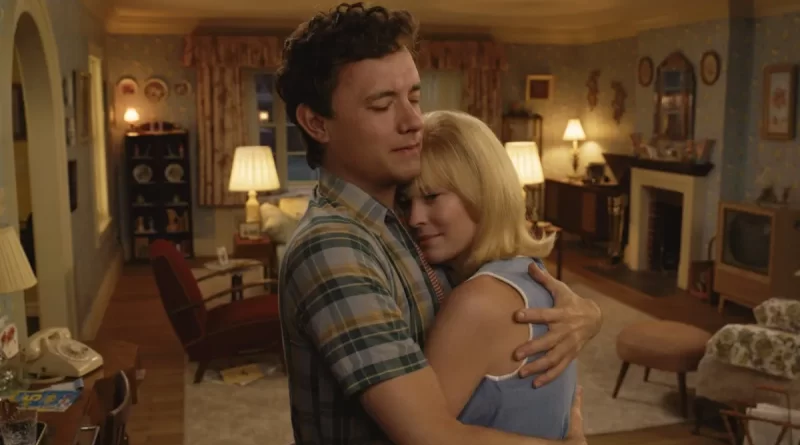Here (2024)
I seem to begin most reviews on the films of Robert Zemeckis by pointing out his affinity for challenging special effects. Here has those in spades, but I’ll get to that later. I’ll instead begin by pointing out his other cinematic affinity, which is time. The center of all three Back to the Future films was a time machine fashioned out of a Delorean. In The Polar Express and Disney’s A Christmas Carol, time is magically altered on Christmas Eve for the benefit of a Santa-doubting boy and a holiday-hating miser. Forrest Gump saw the title character taking part in historic American events across decades. Even Death Becomes Her was about time – or more precisely, the lengths some people will go to avoid the ravages of time.
Now there’s Here, in which time is accepted as a reality we’re all in the grip of. Obviously, this isn’t original on a conceptual level. But the visual level is another story; Zemeckis and his creative team capture the unique structure of Richard McGuire’s graphic novel, including non-chronological panels subdivided into non-chronological mini panels, plot lines set in different eras freely weave in and out of each other, and with the exception of the final scene, the one and only vantage point for the audience doesn’t move. In one scene, it’s the 1960s, and we witness family drama in the living room of a suburban house. In another, it’s millions of years earlier, and we see dinosaurs in a forest fleeing the approach of the comet that drove them to extinction. In another still, it’s the turn of the last century, and we watch the same house being built.
Within this nonlinear narrative are six subplots. The main one follows three generations of the Young family, beginning in the mid 1940s with married couple Al (Paul Bettany) and Rose (Kelly Reilly), the former a World War II veteran with undiagnosed PTSD and a drinking problem, the latter a housewife who puts on a wholesome domestic front but deep within harbors regret over certain life decisions. It continues in the ‘60s and ‘70s with one of their children, artist son Richard (Tom Hanks), whose dreams are put on hold by the realities of marriage and family, and his evolving relationship with the loving but trapped Margaret (Robin Wright) as they live in his parents’ house and raise their child. It concludes between the ‘80s and the near future with the ups and downs of Richard and Margaret in their autumn years, during which their daughter (Zsa Zsa Zemeckis) goes from playful young girl to rebellious teen to successful lawyer.
The other five subplots and their characters: (1) In the 1920s, Lee (David Fynn) and Stella Beekman (Ophelia Lovibond), revel in their successes, one as an inventor, the other as a pinup model; (2) in the century or so prior to European colonization, we follow the shared life journey of a man (Joel Oulette) and woman (Dannie McCallum) from the northeastern Lenni Lenape nation; (3) in early colonial America, we see that Benjamin Franklin (Keith Bartlett) and his son William (Daniel Betts) have been divided by politics; (4) in the early 2020s, the Harris family has a tragic brush with COVID-19, and parents Devon (Nicholas Pinnock) and Helen (Nikki Amuka-Bird) have the talk with son Justin (Cache Vanderpuye) – not the sex talk, but the talk that black families sadly have to have about what their children should and shouldn’t do if pulled over by a cop; (5) in the 1910s, John Harter (Gwilyn Lee) fails to understand why his wife Pauline (Michelle Dockery) doesn’t share his passion for flying, the next big thing.
One of the tragic but inevitable results of advancements in special effects is the diminishing ability to be impressed by them. The use of computers for Here was obviously extensive and painstaking, and I’d be lying if I said I wasn’t charmed by the story’s single vantage point and the panel-within-a-panel technique. I can also appreciate – as I appreciated The Curious Case of Benjamin Button, The Irishman, and Indiana Jones and the Dial of Destiny – for the use of digital de-aging, allowing Hanks and Wright to believably range in age from late teens to elderly. However, it simply isn’t as hard anymore for Zemeckis to achieve his artistic vision. Think back to Who Framed Roger Rabbit, released in 1988; the combination of live action and animation was achieved optically, not digitally. It was a herculean effort that paid off then and still holds up today.
The true compelling aspect of Here is actually very general: Living life. Even with its nonlinear structure, the passage of time is evident, not just in terms of the physical changes but also in terms of the ups and downs most everyone experiences. There are happy moments, some as big as marriage, having children, birthdays, and holidays, some as small as loving words between family members. There are sad moments, including relationship issues, regrets over what someone didn’t do as opposed to what they did, illnesses, death, and the human body increasingly succumbing to the ravages of old age. In that sense, the movie is real. The intention is not to make you feel good or bad, but merely to have us watch the unfolding stories and say, in some capacity, “I can relate to this.” I should think most of us can, for better or worse.




